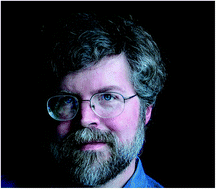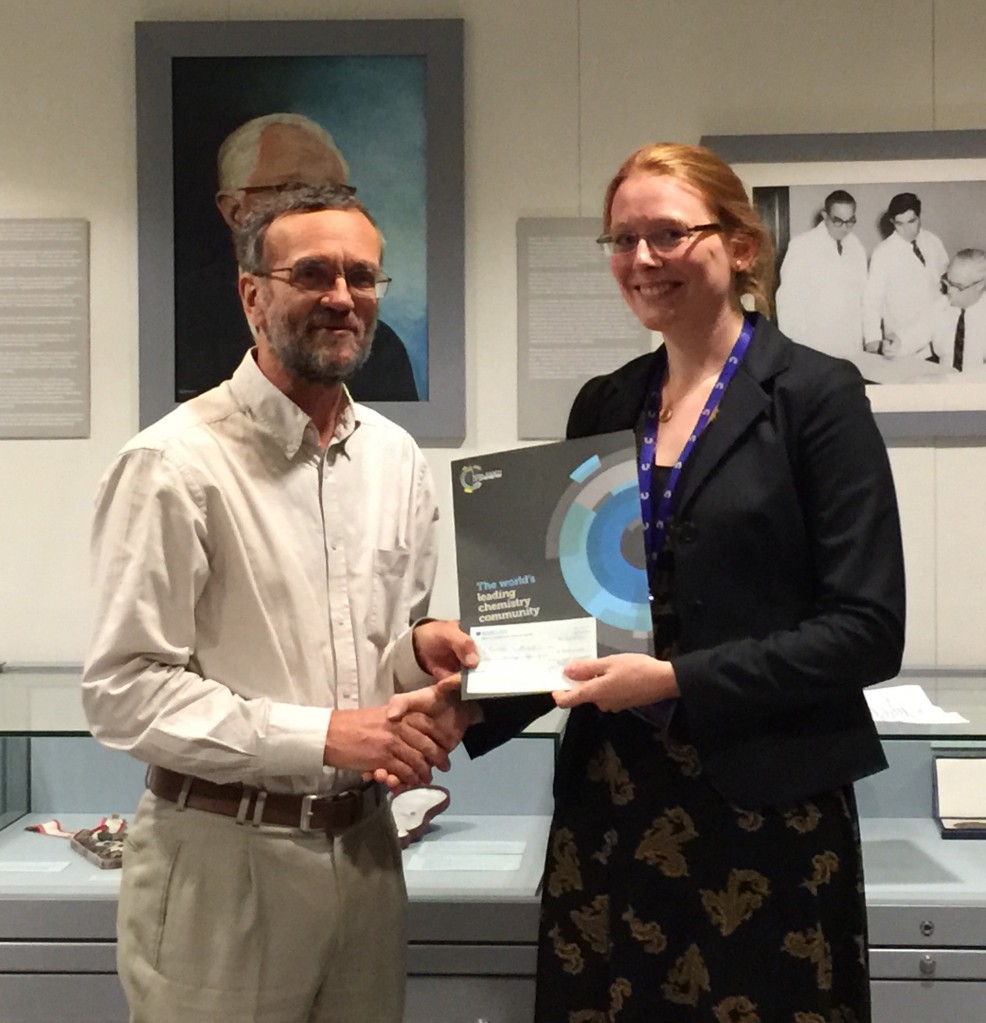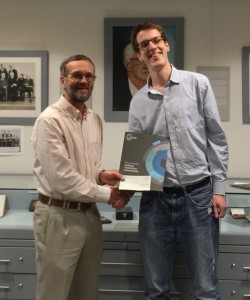
Take a look at the first article in issue 1 of MedChemComm, and look out for further announcements about new features in MedChemComm through the year.

Take a look at the first article in issue 1 of MedChemComm, and look out for further announcements about new features in MedChemComm through the year.
On 12th Decemeber the Biological and Medicinal Chemistry Sector (BMCS) of the Royal Society of Chemistry held its eighth postgraduate symposium for PhD students and postdoctoral workers researching in biological or medicinal chemistry and related areas. The day consisted of 11 oral presentations (8 student and 3 keynote) and poster session.
This year’s symposium was a great success with around 150 participants attending, with an excellent scientific standard all around.
The BMCS judges awarded two prizes on the day; one for the best oral presentation and one for the best poster, with the winners recieving £300 and £150 respectively as well as each getting a year’s subscription to MedChemComm.
Congratulations go to:
Oral presentation winner: Charlotte Sutherell, University of Cambridge for her talk “Bromodomain Inhibitor Development and Testing to Evaluate the Therapeutic Potential of SMARCA4 in SWI/SNF Mutant Cancers”
Poster winner: Niall Igoe, University College London for his poster on “Epigenetic Drug Discovery: Small Molecule Inhibitors of Class IV Bromodomains”
 |
 |
A recent publication in MedChemComm from Doaa A. E. Issa et al.reports the synthesis and biological properties of a series of compounds containing the quinoxaline pharmacophore. Their choice of the quinoxaline motif was inspired by the antineoplastic and antimicrobial activity of other compounds containing this group.
Issa et al. synthesised a total of 15 compounds via a key hydrazino intermediate and evaluated 10 candidates at a single high dose for antitumour activity in the National Cancer Institute-60 cell screen. Compounds showing activity were further evaluated in a multi-dose assay. The team went on to assess the in vitro antibacterial activity and antifungal properties.
They found that several compounds in the series display antibacterial activity and one compound possesses both broad spectrum anticancer activity and antimicrobial activity against Pseudomonas aeruginosa.
Design, synthesis and biological evaluation of novel 1,2,4-triazolo and 1,2,4-triazino[4,3-a]quinoxalines as potential anticancer and antimicrobial agents
Doaa A. E. Issa, Nargues S. Habib and Abeer E. Abdel Wahab
Med. Chem. Commun., 2015, DOI: 10.1039/C4MD00257A
The articles below are the most read MedChemComm articles in July, August and September 2014.
Conformational analysis of peramivir reveals critical differences between free and enzyme-bound states
Michele R. Richards, Michael G. Brant, Martin J. Boulanger, Christopher W. Cairo and Jeremy E. Wulff
DOI: 10.1039/C4MD00168K
A critical assessment of modeling safety-related drug attrition
Daniel Muthas, Scott Boyer and Catrin Hasselgren
DOI: 10.1039/C3MD00072A
Identification of 2,4-diamino-6,7-dimethoxyquinoline derivatives as G9a inhibitors
Nitipol Srimongkolpithak, Sandeep Sundriyal, Fengling Li, Masoud Vedadi and Matthew J. Fuchter
DOI: 10.1039/C4MD00274A
Synthesis of α-brominated phosphonates and their application as phosphate bioisosteres
A. Michael Downey and Christopher W. Cairo
DOI: 10.1039/C4MD00255E
The synthesis and functional evaluation of a mitochondria-targeted hydrogen sulfide donor, (10-oxo-10-(4-(3-thioxo-3H-1,2-dithiol-5-yl)phenoxy)decyl)triphenylphosphonium bromide (AP39)
Sophie Le Trionnaire, Alexis Perry, Bartosz Szczesny, Csaba Szabo, Paul G. Winyard, Jacqueline L. Whatmore, Mark E. Wood and Matthew Whiteman
DOI: 10.1039/C3MD00323J
Identification of an inhibitor of the ubiquitin–proteasome system that induces accumulation of polyubiquitinated proteins in the absence of blocking of proteasome function
Caroline Haglund, Chitralekha Mohanty, Mårten Fryknäs, Padraig D’Arcy, Rolf Larsson, Stig Linder and Linda Rickardson
DOI: 10.1039/C3MD00386H
Affinity-based target identification for bioactive small molecules
Makoto Kawatani and Hiroyuki Osada
DOI: 10.1039/C3MD00276D
Anaplastic lymphoma kinase (ALK) inhibitors: a review of design and discovery
Wen-Chieh Wang, Hui-Yi Shiao, Chieh-Chien Lee, Ka-Shu Fung and Hsing-Pang Hsieh
DOI: 10.1039/C4MD00048J
Structure-based approaches towards identification of fragments for the low-druggability ATAD2 bromodomain
Apirat Chaikuad, Andrew M. Petros, Oleg Fedorov, Jing Xu and Stefan Knapp
DOI: 10.1039/C4MD00237G
 Can you explain the importance of chemistry to human health in just 1 minute? If you’re an early-career researcher who is up to the challenge, making a 1 minute video could win you £500.
Can you explain the importance of chemistry to human health in just 1 minute? If you’re an early-career researcher who is up to the challenge, making a 1 minute video could win you £500.
The chemical sciences will be fundamental in helping us meet the healthcare challenges of the future, and we are committed to ensuring that they contribute to their full potential. As part of our work in this area, we are inviting undergraduate and PhD students, post-docs and those starting out their career in industry to produce an original video that demonstrates the importance of chemistry in health.
We are looking for imaginative ways of showcasing how chemistry helps us address healthcare challenges. Your video should be no longer than 1 minute, and you can use any approach you like.
The winner will receive a £500 cash prize, with a £250 prize for second place and £150 prize for third place up for grabs too.
Stuck for inspiration? Last year’s winning video is a good place to start. John Gleeson’s video was selected based on the effective use of language, dynamic style, creativity and its accurate content.
The closing date for entries to be submitted is 30 January 2015. Our judging panel will select the top five videos. We will then publish the shortlisted videos online and open the judging to the public to determine the winner and the runners up.
For more details on how to enter the competition and who is eligible, join us at the Take 1… page.
Good luck!
The following MedChemComm articles have all been recommened by the reviewers of the articles as being particularly interesting or particularly significant research. These have all been made free to access until 12th December 2014. The order they appear in the list holds no special meaning or ranking.
Imidazole derivatives show anticancer potential by inducing apoptosis and cellular senescence
Gangavaram V. M. Sharma, Adepu Ramesh, Ashita Singh, Gourishetty Srikanth, Vankudoth Jayaram, Divya Duscharla, Jung Ho Jun, Ramesh Ummanni and Sanjay V. Malhotra
DOI: 10.1039/C4MD00277F, Concise Article
Optimisation of a triazolopyridine based histone demethylase inhibitor yields a potent and selective KDM2A (FBXL11) inhibitor
Katherine S. England, Anthony Tumber, Tobias Krojer, Giuseppe Scozzafava, Stanley S. Ng, Michelle Daniel, Aleksandra Szykowska, KaHing Che, Frank von Delft, Nicola A. Burgess-Brown, Akane Kawamura, Christopher J. Schofield and Paul E. Brennan
DOI: 10.1039/C4MD00291A, Concise Article
From themed collection Epigenetics
Computationally motivated synthesis and enzyme kinetic evaluation of N-(β-D-glucopyranosyl)-1,2,4-triazolecarboxamides as glycogen phosphorylase inhibitors
Jaida Begum, Gergely Varga, Tibor Docsa, Pál Gergely, Joseph M. Hayes, László Juhász and László Somsák
DOI: 10.1039/C4MD00335G, Concise Article
Synthesis and biological evaluation of a series of aryl triazoles as firefly luciferase inhibitors
Haixiu Bai, Peng Zhu, Wenxiao Wu, Jing Li, Zhao Ma, Wei Zhang, Yanna Cheng, Lupei Du and Minyong Li
DOI: 10.1039/C4MD00368C, Concise Article
Rational design of protein–protein interaction inhibitors
Didier Rognan
DOI: 10.1039/C4MD00328D, Review Article
The 10 most accessed MedChemComm articles between April and June 2014
During the months April – June 2014, the most downloaded MedChemComm articles were:
The synthesis and functional evaluation of a mitochondria-targeted hydrogen sulfide donor, (10-oxo-10-(4-(3-thioxo-3H-1,2-dithiol-5- yl)phenoxy)decyl) triphenyl phosphonium bromide (AP39)
Sophie Le Trionnaire, Alexis Perry, Bartosz Szczesny, Csaba Szabo, Paul G. Winyard, Jacqueline L. Whatmore, Mark E. Wood and Matthew Whiteman
DOI: 10.1039/C3MD00323J
Emerging classes of armed antibody therapeutics against cancer
Christian Hess, Dario Venetz and Dario Neri
DOI: 10.1039/C3MD00360D
The role of modern drug discovery in the fight against neglected and tropical diseases
Jeremy N. Burrows, Richard L. Elliott, Takushi Kaneko, Charles E. Mowbray and David Waterson
DOI: 10.1039/C4MD00011K
Discovery of BET bromodomain inhibitors and their role in target validation
S. Müller and S. Knapp
DOI: 10.1039/C3MD00291H
Identification of an inhibitor of the ubiquitin–proteasome system that induces accumulation of polyubiquitinated proteins in the absence of blocking of proteasome function
Caroline Haglund, Chitralekha Mohanty, Mårten Fryknäs, Padraig D’Arcy, Rolf Larsson, Stig Linder and Linda Rickardson
DOI: 10.1039/C3MD00386H
Ambient mass spectrometry technologies for the detection of falsified drugs
María J. Culzoni, Prabha Dwivedi, Michael D. Green, Paul N. Newton and Facundo M. Fernández
DOI: 10.1039/C3MD00235G
Affinity-based target identification for bioactive small molecules
Makoto Kawatani and Hiroyuki Osada
DOI: 10.1039/C3MD00276D
Fragment growing to retain or alter the selectivity of anchored kinase hinge-binding fragments
Charlotte E. Allen, Amanda J. Welford, Thomas P. Matthews, John J. Caldwell and Ian Collins
DOI: 10.1039/C3MD00308F
Two diseases, one approach: multitarget drug discovery in Alzheimer’s and neglected tropical diseases
F. Prati, E. Uliassi and M. L. Bolognesi
DOI: 10.1039/C4MD00069B
FP tethering: a screening technique to rapidly identify compounds that disrupt protein–protein interactions
Jean M. Lodge, T. Justin Rettenmaier, James A. Wells, William C. Pomerantz and Anna K. Mapp
DOI: 10.1039/C3MD00356F
The following are HOT articles, as recommened by the reviewers of the articles. These have all been made free to access until 24th October:
Structure-based approaches towards identification of fragments for the low-druggability ATAD2 bromodomain
Apirat Chaikuad, Andrew M. Petros, Oleg Fedorov, Jing Xu and Stefan Knapp
Med. Chem. Commun., DOI: 10.1039/C4MD00237G, Concise Article
From themed collection Epigenetics
Gold compounds as aquaporin inhibitors: new opportunities for therapy and imaging
Andreia de Almeida, Graça Soveral and Angela Casini
Med. Chem. Commun., DOI: 10.1039/C4MD00265B, Review Article
A novel surface-coated nanocarrier for efficient encapsulation and delivery of camptothecin to cells
Rie Wakabayashi, Ryutaro Ishiyama, Noriho Kamiya and Masahiro Goto
Med. Chem. Commun., DOI: 10.1039/C4MD00179F, Concise Article
From themed collection In celebration of Seiji Shinkai’s 70th Birthday
Peptide HIV fusion inhibitors: modifications and conjugations
Wei Liu, Jianjun Tan, Mohammadreza Mohammadzad Mehryar, Zhiping Teng and Yi Zeng
Med. Chem. Commun., 2014, Advance Article
DOI: 10.1039/C4MD00214H, Review Article
3,5-Diamino-1,2,4-triazoles as a novel scaffold for potent, reversible LSD1 (KDM1A) inhibitors
Craig J. Kutz, Steven L. Holshouser, Ethan A. Marrow and Patrick M. Woster
Med. Chem. Commun., 2014, Advance Article
DOI: 10.1039/C4MD00283K, Concise Article
From themed collection Epigenetics
Registration now open for Medicinal Chemistry Residential School 2014
With a 40 year history in the UK, the Royal Society of Chemistry Medicinal Chemistry Residential School has trained some of the world’s leading medicinal chemists working in the pharmaceutical industry. Now, for the first time, this highly successful course will be coming to Asia – from 20-23 November, Shangai, China.
Do you want to develop your medicinal chemistry skills?
This 3-day course strengthens excellence in medicinal chemistry by highlighting best practice and facilitating understanding of the factors governing modern drug discovery.
What you will learn
The course covers all aspects of drug discovery. A full list of themes is on our website. These topics will be explored through a varied programme of lectures, case histories, and hands-on tutorial sessions.
Who you will learn from
This is a truly unique opportunity for discussions and networking with peers and internationally recognised leaders in the field. See our list of prestigious speakers.
Registration is now open. There are limited spaces available on the course so make sure you register as soon as possible.